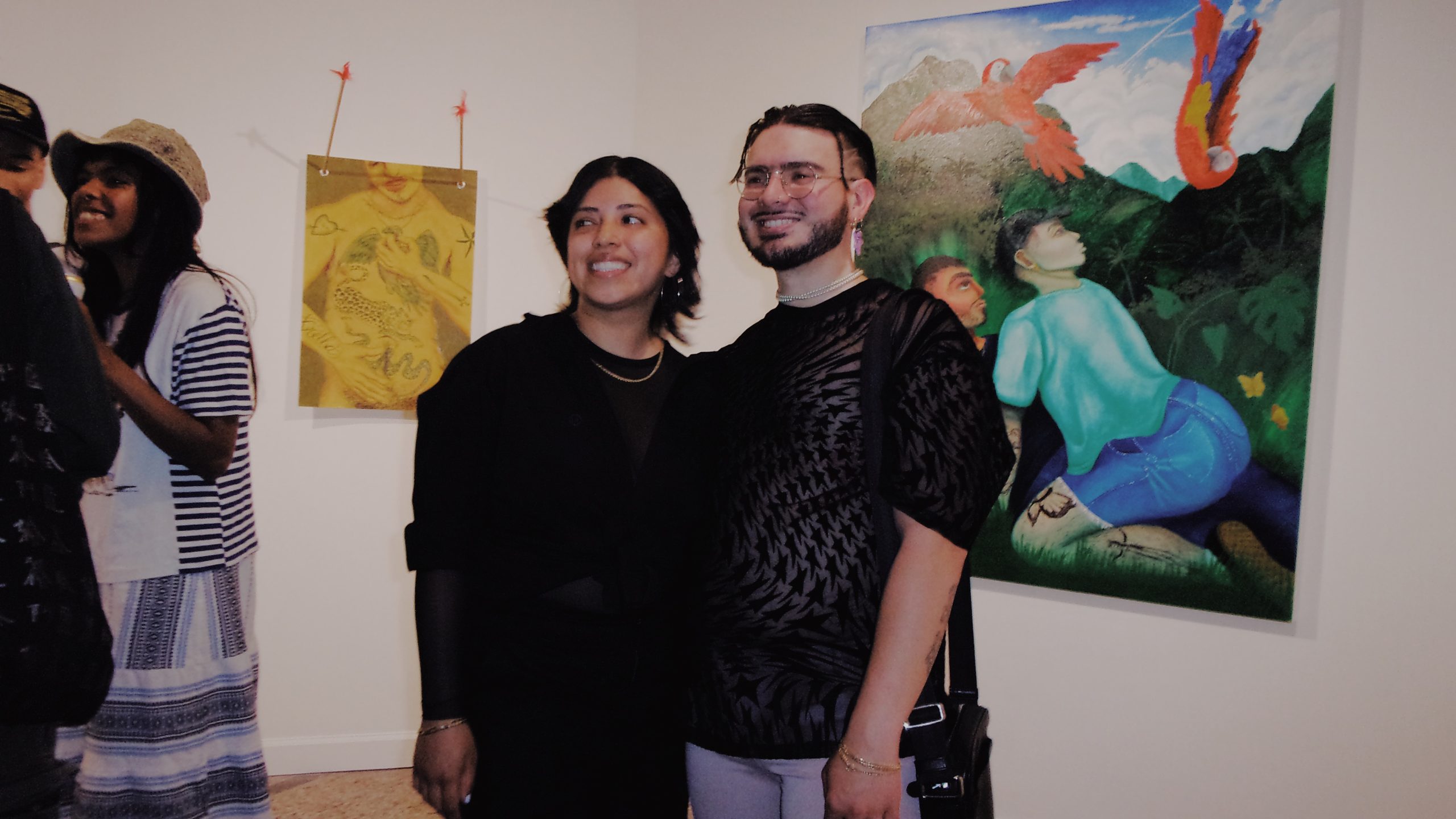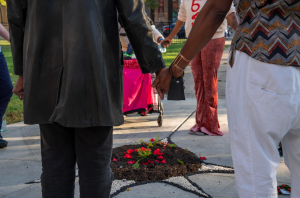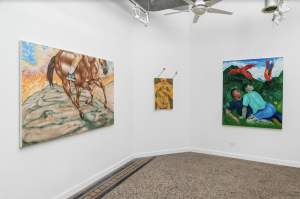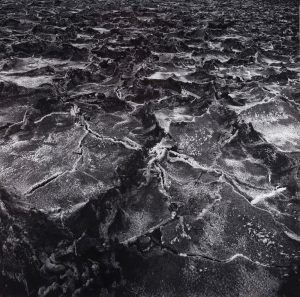
Before seeing the show, I was curious about the title of the exhibition, El Brillo En Sus Ojos. My thoughts immediately went to “Umbrella” by Rihanna. Her lyrics go, “When the sun shines, we’ll shine together. Told you I’ll be here forever.” I started to think through the connections embedded between El Brillo En Sus Ojos–a duo exhibition by Vani Aguilar and Juan Arango Palacios at Roots & Culture Contemporary Art Center and the song. Both artists bring us a queer, chosen familial portrait of Latinx identity in Chicago.
Much of the show reflects Palacios’ and Aguilar’s friendship. Their culmination of various mediums showcases what they were trying to elevate: queer family. Your chosen family. Growing up in a Mexican household, there is pushback to being openly queer like many Latinx cultures. Often the machista and homophobic tendencies lead to ostracization. The artist-duo is taking this harmful culture and shifting the narrative to create a world far away from this.
What does Latinx culture look like when it holds open arms for queer folks? How can queering the culture shift the dynamics at play? By imagining and creating these beautiful worlds of love and care, with the help of our chosen family, many queer folks that were not accepted by their blood family conjure up these imagined worlds to turn them into a reality.
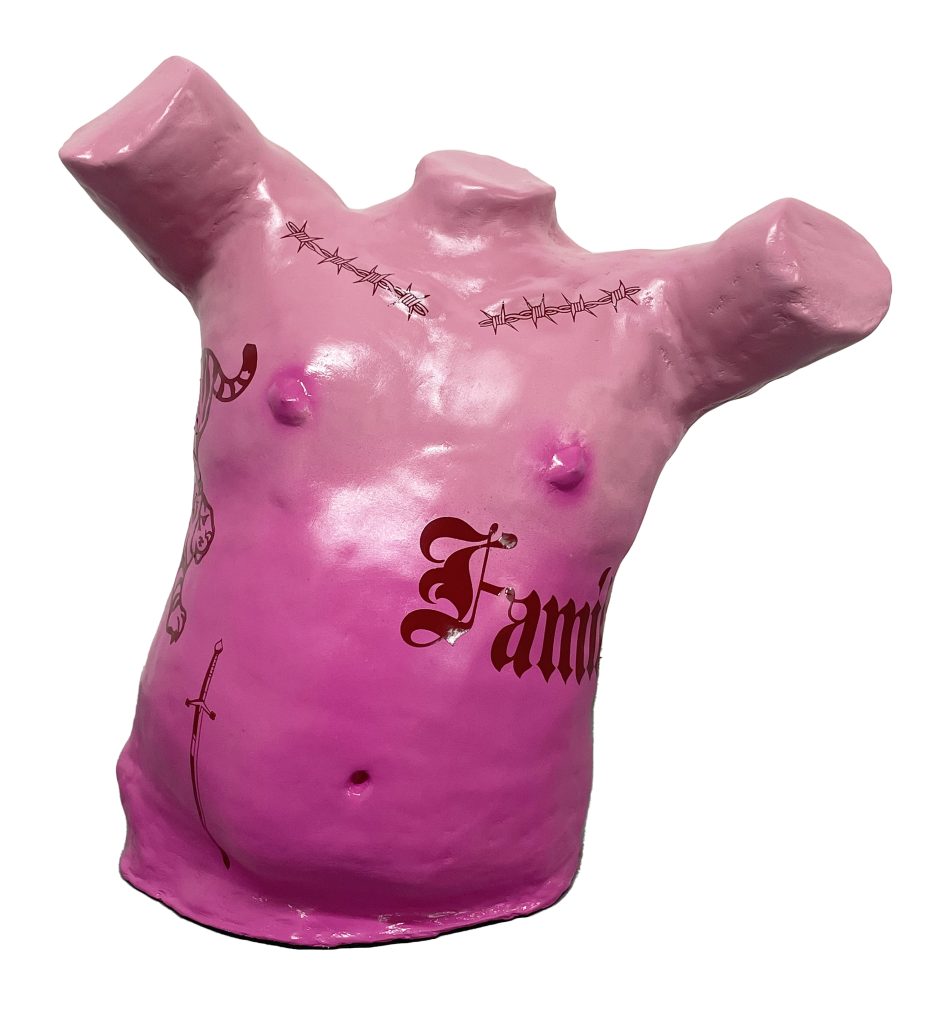
One of the first works I noticed as I walked into the space is Palacios’ sculpture, Family Man. It is a bright pink ombre torso with no arms and tattoos. It is made out of acrylic and vinyl on plaster. The color and tattoos draw me in. The theme of family is seen throughout many of Palacios’ other pieces in the gallery. There’s this nod to a family that you want to have branded on yourself because it means so much to you.
The material each artist uses adds to one another. Palacios uses a lot of rhinestones and embellishments and Aguilar creates shiny surfaces with their pencils. Both artists are capitalizing on the shine in each other’s pieces. One cannot exist without the other.
In the hallway, Palacios and Aguilar continue to build on the momentum of brillo where two of Aguilar’s pieces showcase their prowess. The delicate fine lines create a shiny surface that deceives you. It’s a flat surface, but it is jumping out of the paper. As for Palacios, they are using more rhinestones to embellish the panel of their works. Their placements point you in all the right directions.
The exhibition really shines with the display method some of the pieces take up. In the main gallery, Palacios hangs Al Vapor with a shower curtain rod and hoops. It gives the piece a play on the subject matter since it feels like you are peeking into this private environment of a shower. This is also another of the pieces where one of the subjects is adorned by a “Family” tattoo. This isn’t the first time Palacios has experimented with different ways to display their works. In a solo exhibition at Jude Gallery, Amor de Mis Amores, they used cupid’s arrows to hang their works. Aguilar does the same with experimenting with different hardware to bring their works to life. In Como de Costumbre, Navego en la Lumbre, they use silver chains to bring out the silver chain link fence in the background of the drawing. Both artists are quite literally highlighting the importance of creating these worlds where queer love and family can co-exist with no homophobia or machismo to stop it in its tracks–a safe haven.
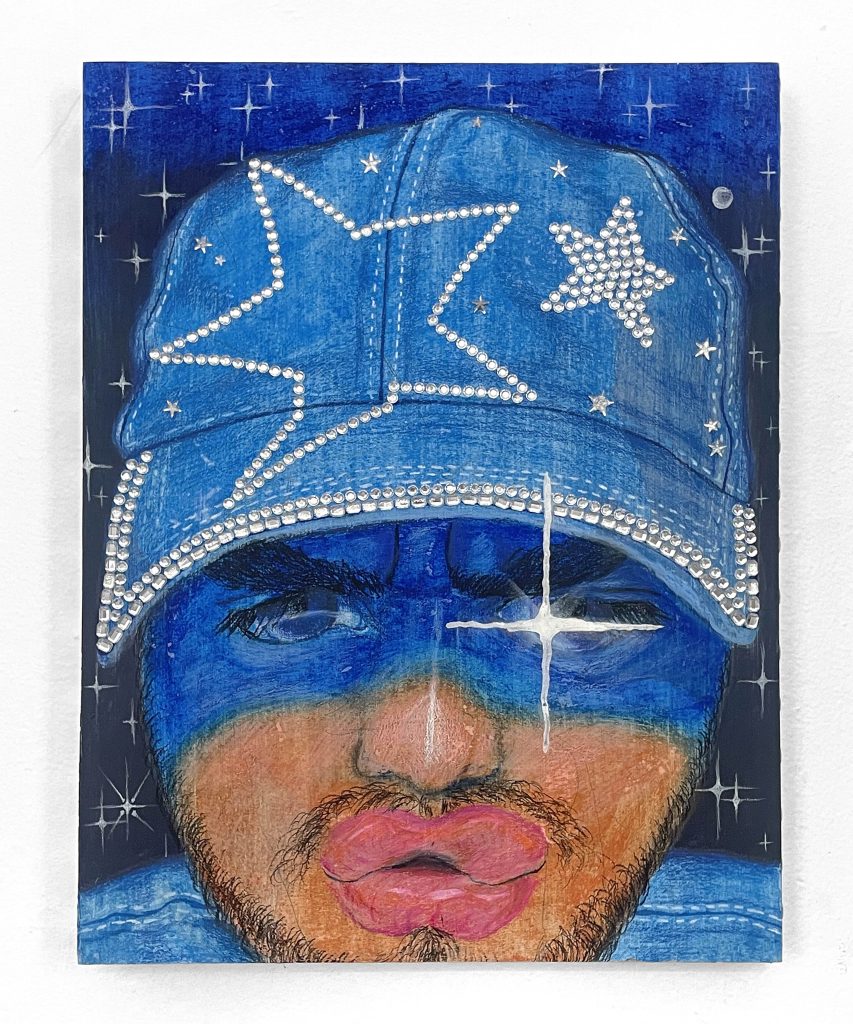
The following interview has been edited for clarity and length.
Cristobal Alday: Hi Vani. Tell me a little about yourself and your practice.
Vani Aguilar: I am from California originally,Southern California. Pasadena to be exact. I was born and raised there then I came out here for school at SAIC in 2017. It’s been 6 years and that’s why I am leaving. It’s been long enough. And I’m an artist. I’m a painter, a drawer, and I sculpt sometimes. And, what else? 3D animation. I am queer. I love people. What else?
CA: I know it’s such a hard thing to answer.
VA: Yeh, right? Like who am I? But yeah that’s who I am. Did I hit all the points?
CA: Yeh, you hit all the points.
VA: Did I hit all the identifiers? I’m Chicanx.
CA: That’s perfect. What’s been your relationship with Chicago, prior to SAIC, during and after, especially with being from LA?
“I think everyone should leave their hometown, you know? Get a little fresh air. Also, the distance makes you appreciate where you’re from a bit more. A lot more. I remember at the start of moving here, I was very rockera. ‘Cause I was like, I’m different, you know? Then I came here, and I said I miss LA culture. Then I started grasping for it in a nostalgic way; incorporating that a bit more into my identity.”
VA: I feel like it was a big decision to leave. Very important; pivotal decision to make. I think everyone should leave their hometown, you know? Get a little fresh air. Also, the distance makes you appreciate where you’re from a bit more. A lot more. I remember at the start of moving here, I was very rockera. ‘Cause I was like, I’m different, you know? Then I came here, and I said I miss LA culture. Then I started grasping for it in a nostalgic way; incorporating that a bit more into my identity. There I was pushing against it because it was everywhere and I felt different. But, I felt different because I was queer and I didn’t really see that there. So I told myself, let me self-identify in a different way. Like, I didn’t really feel like I belonged with other groups of Chicanxs out there. The little Cholitos, they don’t fuck with me because I am queer. The Vaquera girls, they don’t fuck with me either because I am queer. So I was like, I’ll be a rocker, like an Emo. And that’s what it is, you’re against the grain. Coming out here, I felt very lonely. I wasn’t seeing my culture except 26th Street. Love it over there. So, I really started to dive into a lot of LA culture and really use it to visually make it apparent to other people. I need community. I got my little slick back haircut and pachuco look. Before gravitating to it, it was easier to read. They were like “Oh, I see you.”And then that’s how I made friends. Chicago definitely brought out my love for my Chicano heritage more. Also, it’s really queer here. So, that was really liberating. I was able to embrace that a lot more. I think it’s the [distance] to the border. That’s why Chicago is so queer. It’s so visible here. [In LA] the traditions are so hard because we’re right there. All of it is just so in your face all the time. But here it’s far. There’s a lot of generations also. There’s a lot of Mexicans that have been here for a while so it seems more of a distance from the pueblo mentality. Very machista.
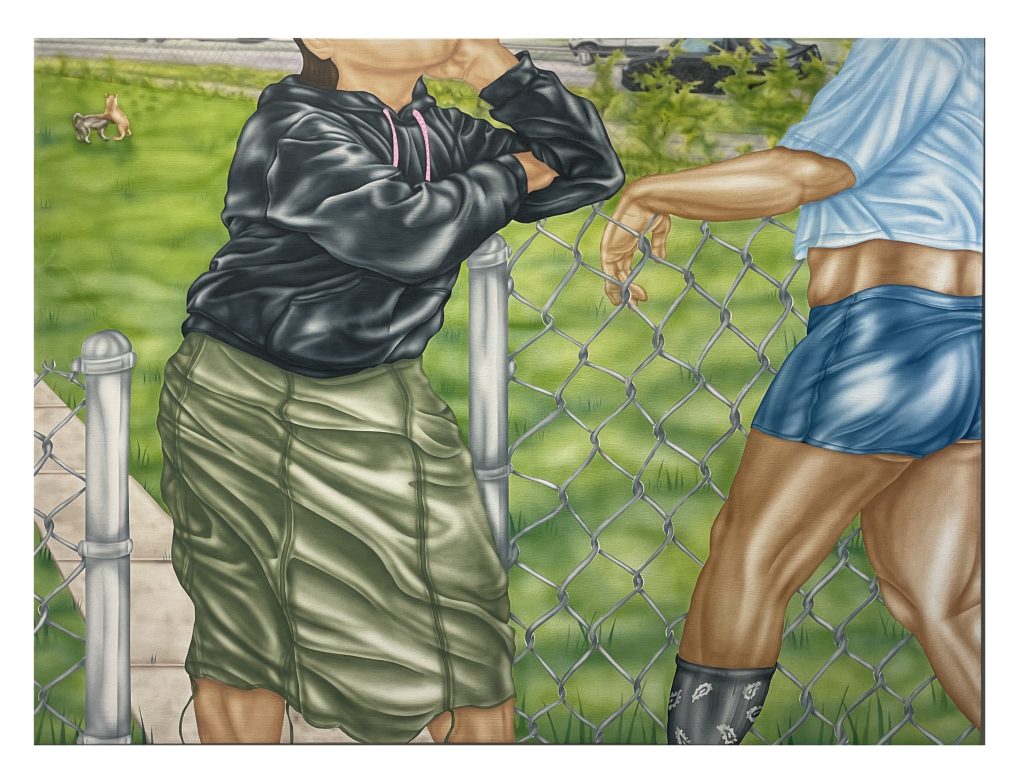
CA: No, that’s a good point. The signifiers, especially in the queer community, we all have these signifiers and we’re like “I see you.” It’s like our own way of communicating with one another what we had to build over the years due to safety concerns. Even LA culture and Chicanx culture, you do certain things and people recognize it. So I like that you embraced that and wanted those people to come to you. Also, the being farther from the border and being queer concept is something I want to hear more about.
VA: I just like to think about why things are sometimes and I’ve come to an understanding of why it’s so queer here. Maybe it’s just proximity to my family too, but it’s also like things culturally from a Mexican perspective feel taken a bit further. Maybe assimilated in a way. A little bit more radical for that reason. There, it’s literally 4 hours from the border. It just feels more reserved. Those are just my thoughts.
CA: How did the Midwest shape your artistic practice?
“This is for my community at the end of the day.”
VA: I think the same way it impacted me as a person. Before I got here, I’d say my work was less culturally communicated. I was still with my family so it was more outer space vibes. Coming here, especially SAIC, there weren’t like minded people or people that came from similar walks of life. Talking about the wealth gaps within the institution. Working class, People of Color, so it was very isolating. I was a part of Latinx Unidxs. I used to run that and Juan was there too. That’s how we got close. I was doing anything I could to find community. It was another way of this is who I am, who I want to cater to. This is for my community at the end of the day. It definitely really shaped it. Missing home so much and incorporating that vocabulary and turning it into my own.
CA: Why are you going back to LA? I know you said it’s been 6 long years.
VA: It’s been 6 long years. Well, it’s my home, right? My people are over there. I have people here now too. My family is there, and my dad is getting older. I think I try to make it apparent in my work, but the thing that I am trying to focus on is the people I feel connected to. My community. The people in my life are very important to me. I just want to be there with them, walk life with them and I also want to go to UCLA for grad school. My partner is also over there and we met at SAIC. And, I’m sure they wouldn’t have known if i wasn’t dressing like it. But yeah those are the reasons. Also, I’ve been making this work and I am starting to feel really distant from it. It feels like a lot of memories but I need it to feel like actively what is happening; more current. I want to see what other Chicanxs are up to.
CA: So, you’re not leaving because of winter, right? Or is that a reason too?
VA: Yeah, no, winter sucks! It’s awful. I love being outside. I love the streets. I love seeing people. Just being on the ground and I feel like I can’t do that here. When Spring started, I got to see all the queers again. We made it through winter! It’s so nice to see you all. I just want to be around people more.
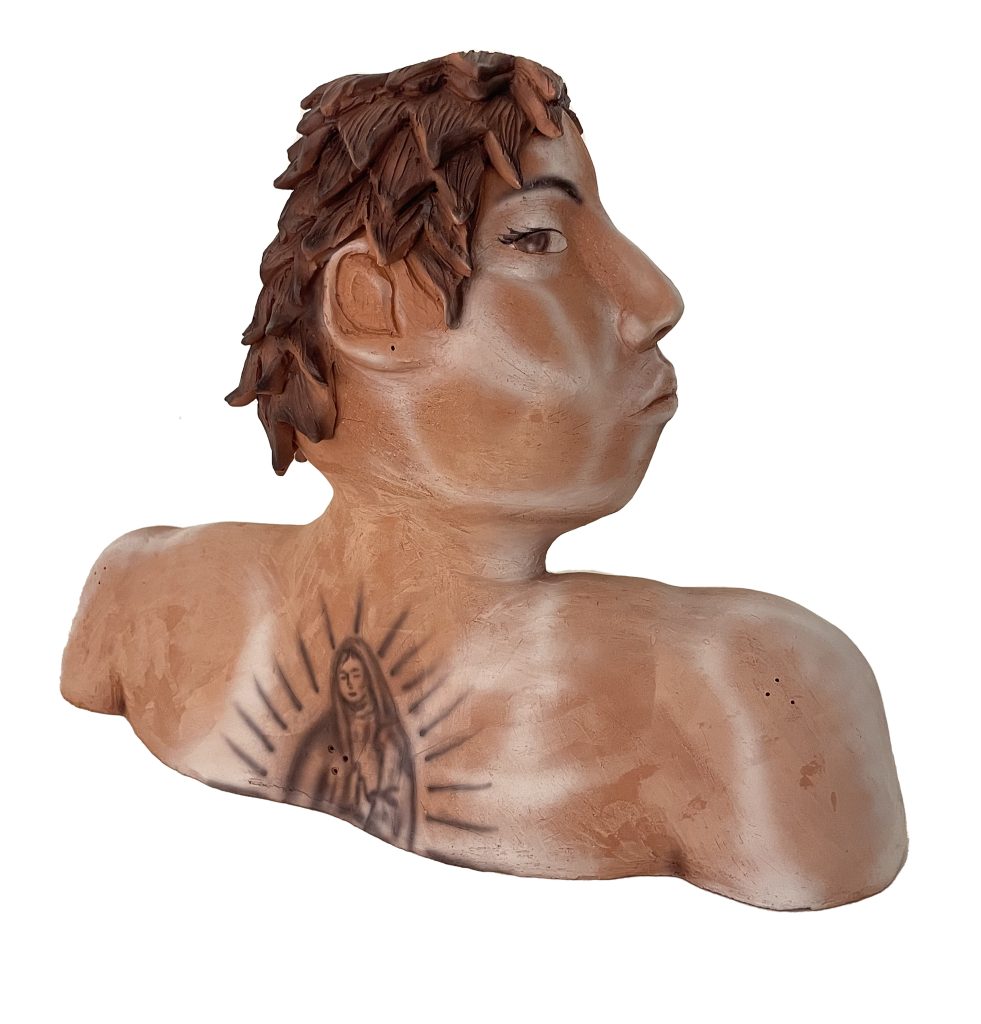
CA: I like the concept you’re talking about too. Maybe you’ve pulled all your memories already so you want to make more so they can impact your work. You want to be in real time almost, instead of pulling from the past.
VA: I just want it to be relatable to a large span of people. Right now, it’s very personal. It seems like people are relating to it still but I want to have it more reeled in.
CA: What does the bridge between California and Chicago look like? Do our communities have potential to merge at all?
“Pilsen and Little Village feel like East LA.”
VA: What is the bridge? Pilsen and Little Village feel like East LA. There’s a lot of distance culturally, not just space, but the kind of Chicano that I represent and grew up with, is very foreign here. I think people here are very nostalgic for it in a way. Everything we see is very 90s. Very glamorized, not all the time but you know? It’s more of a memory so you think highly and positively about it. You forgot about the hardships. Right now culturally, people are nostalgic for it. I’m going to say it, Chicago feels left out from that era. I wonder what that bridge is because it feels very separate. But, I don’t think it needs to be. I think people need to travel and build connections. I know a lot of people come here for school from Southern California and they go back. Chicago keeping us in their grace. I feel like Chicago artists need to be showing out there too.
CA: That falls into my second question of how communities can merge and maybe you can be that bridge too. I agree that there needs to be more cross collaboration. LA artists can come here and show more and Chicago artists can go there and show more. I don’t really hear about too many Chicago artists showing in LA, but maybe I’m wrong.
VA: I think you’re right, unfortunately. I know people here from there, come here and then show there. I think LA loves itself. We have so many artists and we’re trying to uplift those. But I don’t think that’s the best for people in general. It’s important for us to keep that in mind and be a bridge. When we had Ale’s performance here, Celeste, they said to hit them up for events in LA. It’s our responsibility to always keep each other in mind.
“To get that glow it’s very delicate work. I am learning to get faster. I have other stuff to do. I have to go see my friends.”
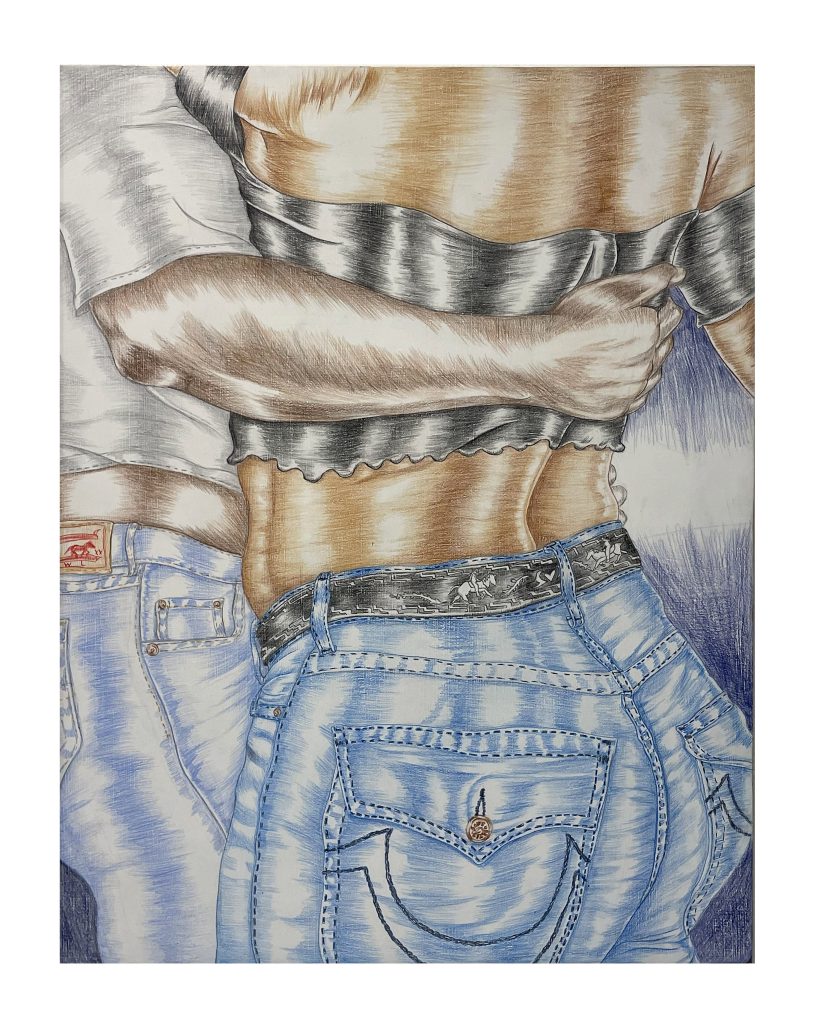
CA: Tell me more about your studio visit with Guadalupe Rosales.
VA: What a treat. I’ve been obsessed with her for some time.
CA: Yeah, her whole crew!
VA: They’re killing it. I think it was 2018. Like I mentioned earlier, I was working with Latinx Unidxs and Sydnie and Haylie Jimenez, they were a part of student government, so they ran everything. They were trying to do programming for visiting artists and I told them I knew the perfect person. Haylie also loves Chicano culture. I told them let’s invite Guadalupe. We brought her over to the school to do an artist talk. We set up studio visits for 10 artists. It was great. My studio visit was the last one since I was organizing it and making sure she was getting everywhere around the Loop. I was trying to spread the resources so she could see the other artists. I showed her my 3D work. I had some 90s backyard music playing. She was really great and sweet overall. It was a really beautiful moment to be able to share work with someone who loves the community just as much. It was really pivotal since it was work that was culturally tied or had that trace to it. My work was very different then. At the time I made these two ceramic pieces that interlocked as a chain. I wanted to make a whole fence but it was a bit too ambitious. One day though! It was around the time that there was news coverage around detention. For me it was really important to take the violence out of the fences. They were these dangerous locations and still are. But in the neighborhoods, they represent home. That’s how you know you’re in a working class community. You go from very plain, iron fences. The iron ones in the Latino community are very decorative. You get these plain ones, then you start seeing chain link fences and the ones with little hearts and bright colors. That’s how I know I am in a neighborhood that is going to welcome me. For me, that moment I was trying to bring back that comfort and love into the space and she really liked it. That was the most important conversation we had but I didn’t even have to explain it to her. It was a signal of community. I still use the chain link fence a lot in my work.
CA: It’s so funny how you were looking around here, ‘cause fences around here are just…
VA: …they’re so boring. There’s nothing. No flavor.
CA: Do you want to have studio visits with other folks whether LA based or Chicago based? Or even collaborations?
VA: Who’s on my dream list? Rafa Esparza. Just people who have so much love in their hearts, I really appreciate. Who else? Jaime Munoz. Alfonso Gonzalez. Unfortunately, a lot of the list is men. Cis men, but that’s more systemic. They need to start giving more people opportunities.
CA: You received the LAVA (Latinx Artist Visibility Award) scholarship in 2019. How did your time at Ox-Bow affect your trajectory as an artist?
VA: I guess when there are these committees that select you, kind of like here with Roots and Culture, you feel very helped and supported. That was my first time, it was technically for school, but it very much felt like a residency. It was a push to keep going. It was a good opportunity to meet artists around the US. I still keep in contact with some of the instructors. It felt like I could get space. It’s always appreciated when people support me.
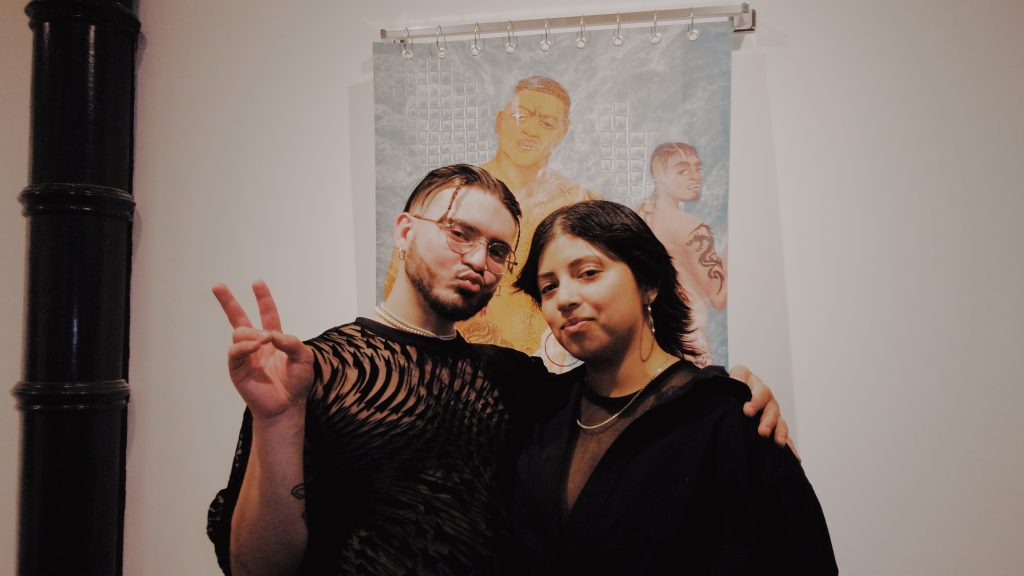
CA: I have been following your work for some time and first stumbled upon it through Juan Palacios actually. You two are best friends, besties.
VA: And roommates.
CA: And roommates. As you mentioned earlier, you are also friends with Haylie and Sydnie. I know your friends with Moises and even did a group show together. I would love to hear about those relationships and how they influence your work but also how you all influence each other as well.
“They’re my family. Those are the people I lean on on a day to day basis. They show up in my work sometimes. I show up in their work sometimes. We just have this tender love towards each other. We’re all artists dealing with the same things. It’s nice and we’re all in different stages in our careers so we can support each other.”
VA: Juan and Haylie were my first group of friends in Chicago. Juan was my first friend ever. We had literature from Latin America. I was always trying to find those kinds of classes. I met Sydnie and Haylie that same semester and we became friends since our first hangout. They are the reason I have been here for so long and why it’s been pleasant. They are my family away from California. My queer family. They are always so supportive. I am getting emotional because I am leaving. I have been reminiscing a lot and looking at old pictures. We have been through so much together. How has that influenced my work? When I was trying to figure out what work I wanted to do after getting my BFA, I was questioning what I wanted to make work about. What do I care about? They’re my family. Those are the people I lean on on a day to day basis. They show up in my work sometimes. I show up in their work sometimes. We just have this tender love towards each other. We’re all artists dealing with the same things. It’s nice and we’re all in different stages in our careers so we can support each other. Handling sales, professional relationships. We all have these nuggets of learning to support each other.
CA: That’s beautiful. I just feel like having a queer family is so important anywhere you are. Y’all can pull from each others’ knowledge. I love that they show up in the work too. I often think about how we put love with a partner on a pedestal and yall are putting friendship at the forefront. I want to hear more about the Tattoos for the Homies account and how that came to be?
VA: Tattoos for the homies LOL. I started doing stick and pokes when I was 18. Then I started doing some on my friends. Tattooing has become popular over the years. A way to decorate your body; a way to signify to other people. So I said let me start decorating myself. Let me have some artwork on myself. People wanted to get some from me. It was mostly friends. A lot of Chicano stuff. LIttle cholito angels and cherubs with hoops and stuff like that. I am only tattooing my friends. It wasn’t for a career or to make money. So you know tattoos for the homies. It turned into a form of care. It was like doodling or painting your nails, but more permanent.
CA: No, you bring up a good point. I was talking to someone about how I havent found a consistent tattoo person. All my tattoos are by different people just because I haven’t found that connection to one given artist, maybe eventually. But I love tattoos and I like that you said it’s more intimate when you’re having these sessions.
VA: It is intimate and they’re also investing in a little piece of you. It’s always going to be there on their skin.
CA: Speaking of tattoos, you’ve dabbled in so many mediums, do you have a favorite?
VA: Drawing for sure. I do love air brushing too. That’s newer though. I started last January. Drawing is my favorite though. It’s so accessible and there’s this madness to it too. It drives me crazy in the best way. My underdrawings take forever. It needs to look perfect. Autonomically, things need to be. It’s a lot of erasing. If you look at the drawings, there’s these small, very delicate strokes of the pencil. It is a very obsessive feeling. Trying to get the right glow. I just spent so much time and my arms hurt so much lately. It’s just so much madness but I love it. I think I might just babble on about drawing if you don’t stop me.
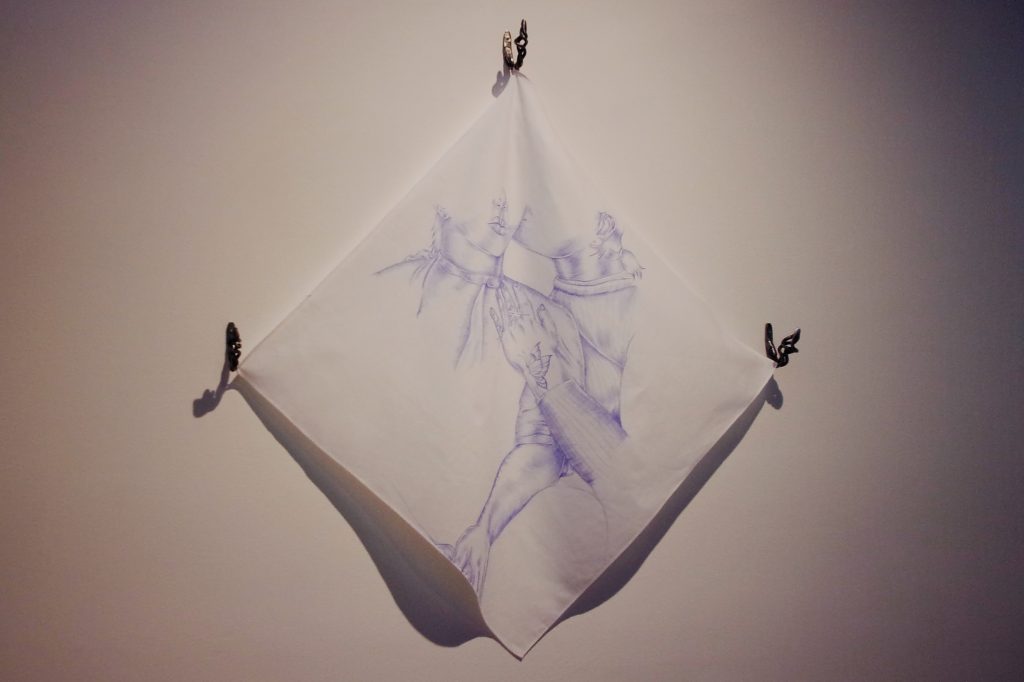
CA: I remember when I first saw the glow, I thought WOW! How do you even get to that? But yes, the obsession is apparent with all the details.
VA: I am referencing a point from paño drawings. So you know, if they haven’t seen those or aren’t aware of them, they originated in prisons. From my research, West Coast. Ball point on a handkerchief. It’s very soft, very delicate. It has a glow to it too. It’s very scratchy scratch like how I do. They’re very fantasy based, like these prison bars with a smoky kind of exiting out it. This dream of being out of jail one day. It has beautiful women and things that are coming up in desire for the people that are incarcerated. That was the first art form I saw. One of my mom’s ex’s was in jail and came back, I asked him what were you doing? I’ve always been nosey, chismosa. I was asking him, “What were you doing for three months?” He said reading books and he started drawing. He showed me his little notebook in that style. Blue ballpoint, very scratchy scratch and soft. That was the first time seeing an artist, an artist like me, not in a museum space or like an art school. A human being who made something pretty. That made me feel like I could do it too. That was very important so I tried to reach for that. Reference it, but not take it entirely because it’s very specific. Right? That’s how I get this look. It’s in full color. Queer. That’s why I love drawing so much because there’s so much background that goes into it. Going back to earlier about nostalgia for the 90s, I don’t think we should be repeating it. We should change it and give it some evolution. A facelift. Make it fresh.
“He showed me his little notebook in that style. Blue ballpoint, very scratchy scratch and soft. That was the first time seeing an artist, an artist like me, not in a museum space or like an art school. A human being who made something pretty.”
CA: Queering it basically.
VA: Yes! Queer it up.
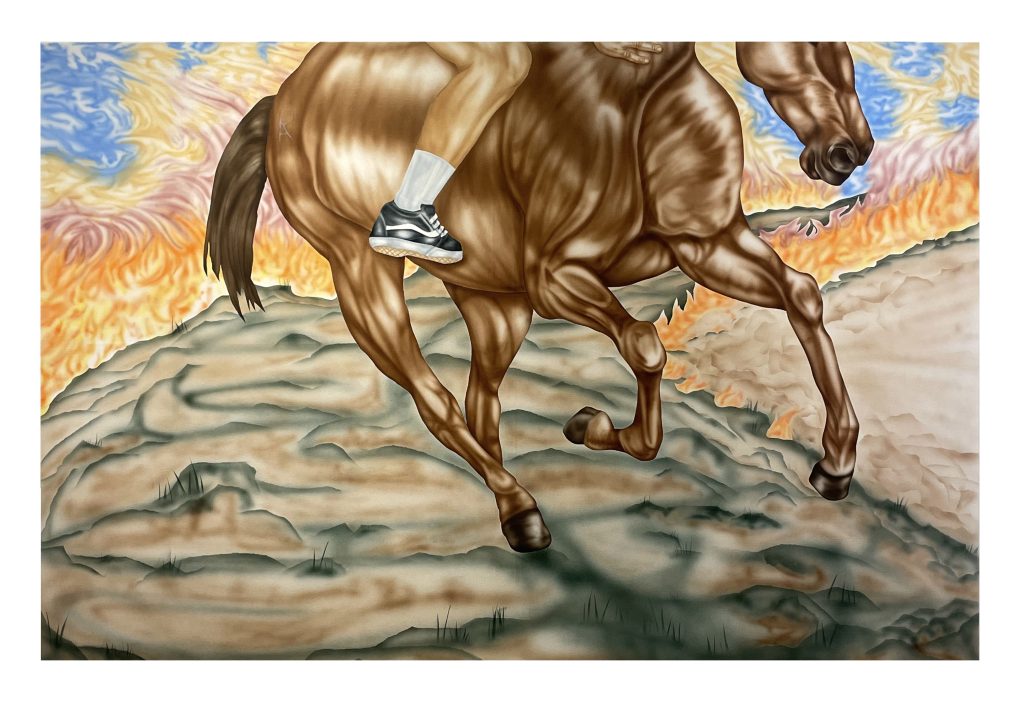
CA: How long do your drawings take to make, if you can measure?
VA: I just made one that’s 32 x 40. My biggest drawing and that took me 3 weeks working everyday. Everyday nonstop. They take a while. To get that glow it’s very delicate work. I am learning to get faster. I have other stuff to do. I have to go see my friends.
CA: I know you have an upcoming solo show in the Fall here in Chicago. Other than that, do you plan on coming back to Chicago?
VA: Yeah, I do. It’s my second home. Chicago has done a lot for me. I feel like I had time to find myself and be the adult that I want to be. Chicago means a lot to me. I will be back for shows, hopefully. Not hopefully, it’s going to happen. As long as Chicago still has open arms for me.
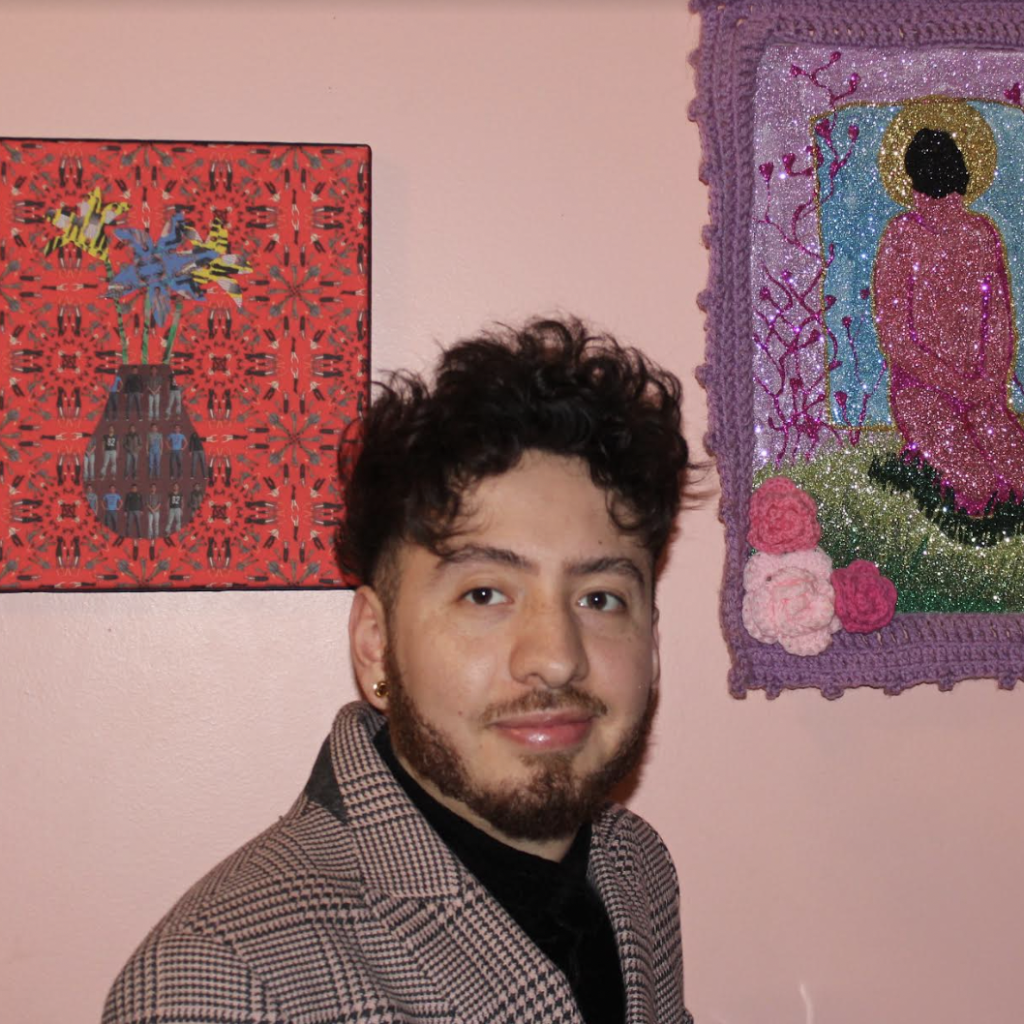
About the Author: Cristobal Alday (he/him) is a Queer Latinx creative from the south side of Chicago. He focuses on photography, and film particularly dealing with queerness, familial dynamics, and space. He is an independent curator currently utilizing his room to curate exhibitions with works by local artists. His artistic practice influences his curatorial and writing approaches. Using collage making and poetic responses, he reflects on artists, their works and exhibitions and focuses on the collaborative aspect of projects and art making through audience interaction via online platforms and in person. Utilizing archival family photographs and influences from around the city, he creates a form of communicating history of the past, present and what could be the future. He has held previous positions at the Art Institute of Chicago-Prints and Drawings Department, Block Museum of Art, Northwestern University: Art Theory and Practice Department, National Museum of Mexican Art, Chicago Artists Coalition, and Johalla Projects. Exhibited at Fundación Universidad del Cine (Universidad del Cine), Buenos Aires, Argentina; Fulton Street Collective, Chicago Illinois; and the Chicago Artists Coalition.
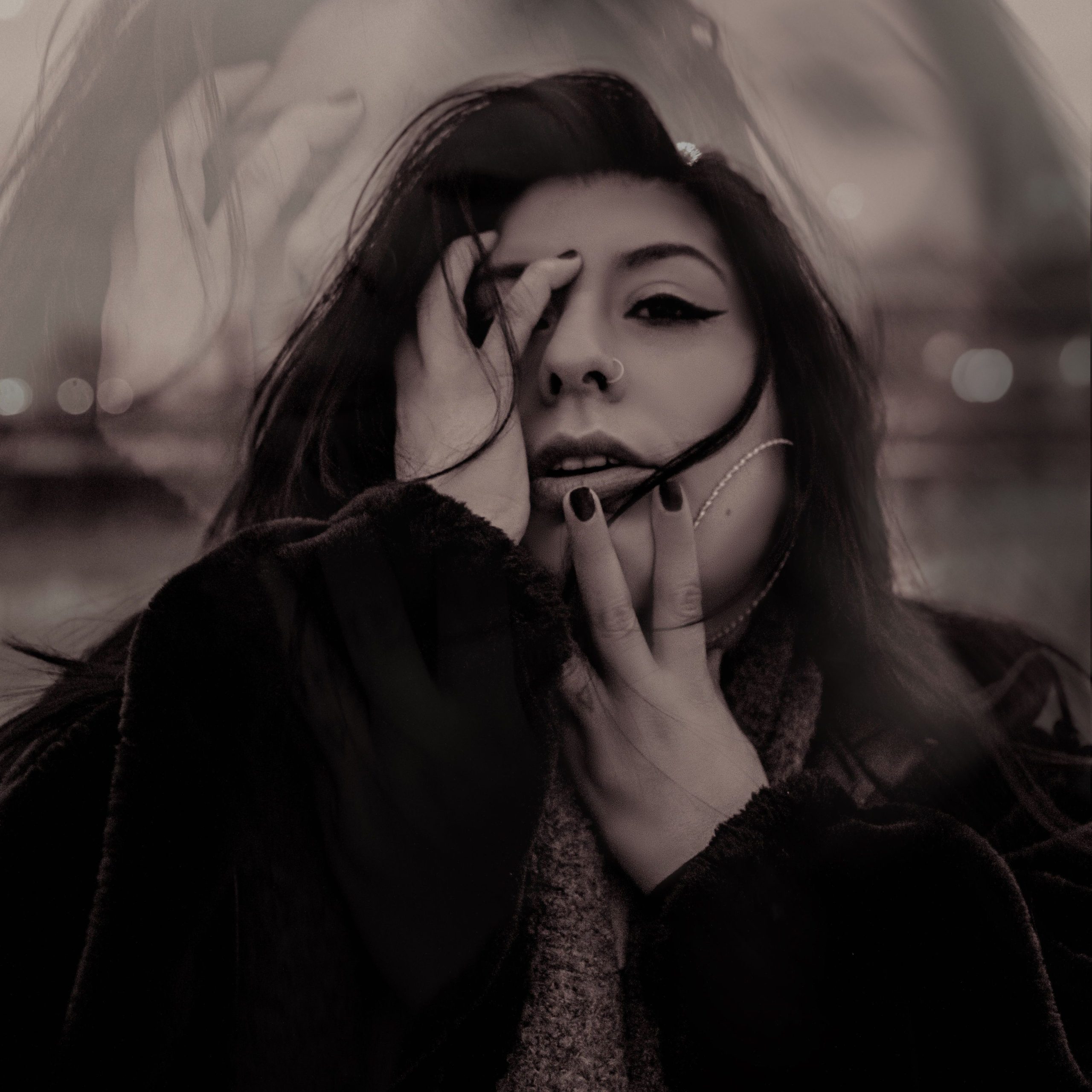
About the Photographer: Luz Magdaleno Flores is Sixty’s Bilingual Editor. She is a Chicana art curator, poet, textile artist, and fotógrafa based in Pilsen by way of Oxnard, California, also known as DJ Light of Your Vida. As a content creator and layout designer she has published La Pera Chapbook, Bajito & Suavecito Foto Zine, Cultura Mexicana en Pilsen y La Villita Chicago (winner of the first place photo book 2016 at Roosevelt University), ¿SERIO? Zine, and edited the last six Brown and Proud Press Anthologies. Her words have been featured on the Chicago Reader, South Side Weekly, Canada’s Broken Pencil Magazine, Xicanation.com, and Reverb LP. @lightofyourvida
